Last Updated on February 22, 2025 by Owen McGab Enaohwo
![What Is Process Automation? [+Benefits, Examples, & Tools]](https://www.sweetprocess.com/wp-content/uploads/2025/02/process-automation.png)
Process automation helps businesses get things done faster, with fewer mistakes, and more efficiently. This allows companies—big or small—to offer better services and stay ahead of the competition.
Take, for example, the healthcare industry. Nurses and doctors in many hospitals spend countless hours on administrative tasks such as filling out forms, tracking records, and managing schedules while still trying to save lives.
However, by adopting automation tools like SweetProcess, hospitals can streamline documentation, scheduling, and record-keeping, enabling professionals to focus on what truly matters—saving lives. This is the transformative promise of process automation across industries.
Research supports this potential. A McKinsey study reveals that 50% of current work activities could be automated with existing technologies. Meanwhile, a Zapier survey highlights that 65% of knowledge workers feel less stressed when repetitive tasks are automated, paving the way for enhanced productivity.
Take the first step toward transforming your workflows—sign up for SweetProcess today and experience the power of automation. All features are unlocked for free within a 14-day trial, requiring no credit card.
What You’ll Learn In This Guide:
How to Implement Process Automation in Your Business
What Are the Benefits of Process Automation?
How to Manage Your Company’s Process Automation Using SweetProcess
5 Process Automation Examples to Implement in Your Business
Best Practices for Process Automation Success
Some Techniques and Terms Used in Process Automation
Challenges of Process Automation
Process Automation vs. Robotic Process Automation
Enhance Your Company’s Process Automation Using SweetProcess
What Is Process Automation?
Process automation is using technology to perform repetitive and manual tasks with little human input. This is achieved through software, robotics, and artificial intelligence, which help organizations streamline operations, improve accuracy, and enhance overall efficiency.
The benefits of automation include eliminating bottlenecks caused by manual processes and allowing businesses to scale more quickly and meet growing demands. Process automation simplifies workflows by identifying routine tasks—such as data entry, email responses, or inventory management—and implementing systems to carry them out automatically.
How to Implement Process Automation in Your Business
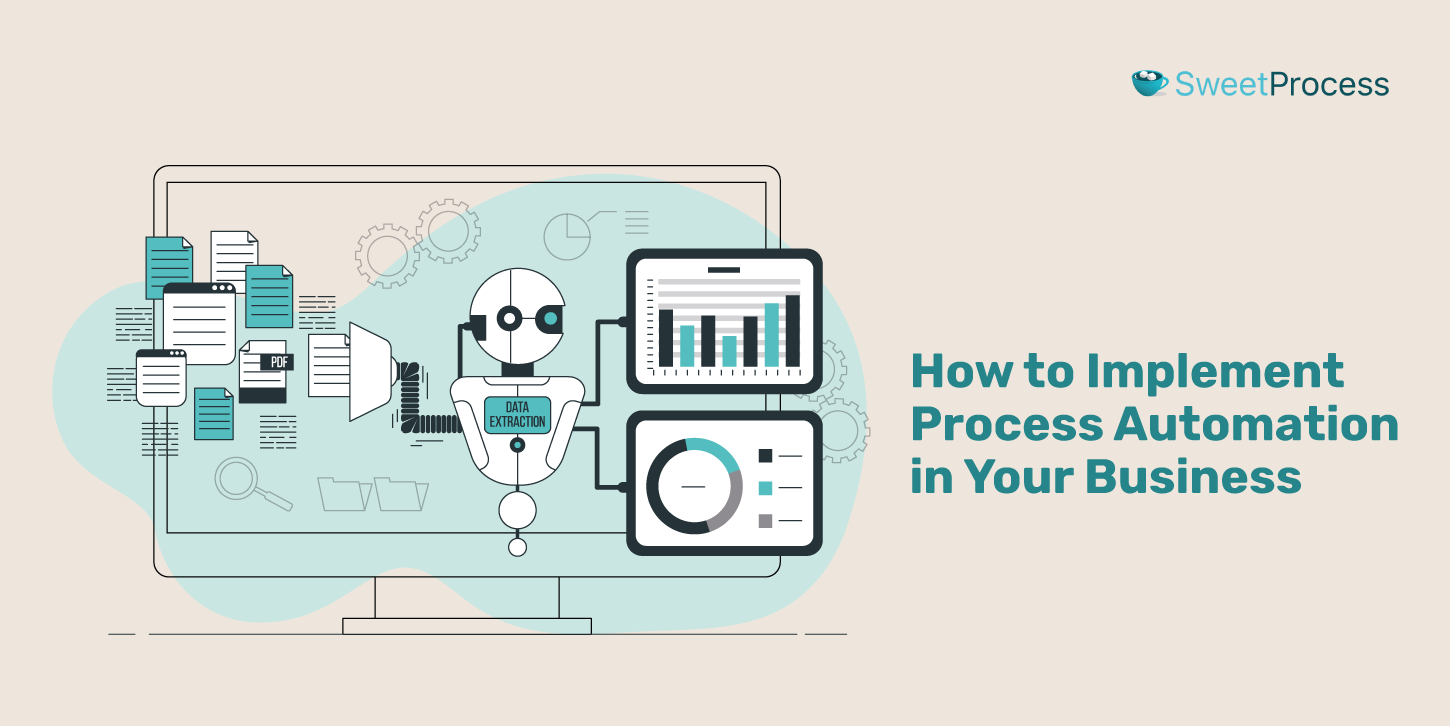
Step 1: Identify Tasks and Processes That Can Be Automated
The first step in implementing process automation is identifying the tasks or processes that will benefit most from automation. Look for tasks that are time-consuming, repetitive, or prone to human error.
Automation isn’t just about replacing human input. It’s about optimizing workflows. For example, processes like invoicing, data entry, scheduling, or handling basic customer inquiries can be automated, freeing up time for your team to focus on more strategic tasks.
Step 2: Set Your Organizational Goals
Automation isn’t a one-size-fits-all solution, so aligning your process automation efforts with your business goals is crucial. For example, if your objective is to achieve faster turnaround times or reduce errors, setting clear goals will help you identify which tasks to automate and define the key performance indicators (KPIs) to track after automation.
Your goals will guide the implementation of automation and provide a framework for evaluating its effectiveness over time.
Step 3: Choose the Right Tools
After identifying the processes to automate and setting clear goals, the next step is selecting the right process automation tools for the job. Numerous automation tools are available, but choosing one that meets your specific needs is essential.
For instance, SweetProcess is an excellent choice for automating routine workflow automation, inventory management, and customer interactions.
When selecting a tool, ensure it integrates seamlessly with your existing systems and offers an intuitive interface that is easy for your team to use.
Step 4: Change Management
Although automation simplifies work, its introduction may be met with reluctance or resistance from employees. Effective leadership is key to overcoming this.
As a manager, communicate the benefits of automation, provide necessary training, and establish feedback channels to address concerns, ensuring a smooth transition and fostering acceptance.
Step 5: Measure and Monitor
Deploying automation tools is just the beginning; ongoing monitoring and measurement are essential for ensuring the system runs effectively. Once automation is in place, management should assess whether tasks are being completed faster, errors are reduced, and other set goals are being achieved.
To track the success of your automation, use key performance indicators (KPIs) to evaluate how well the system is meeting its objectives. Regular monitoring will help identify any areas that need adjustment. If the automation isn’t delivering as expected, adjustments to the system or workflows may be necessary.
What Are the Benefits of Process Automation?
Efficiency Boost
Process automation significantly enhances efficiency by handling routine and time-consuming tasks, freeing up valuable time and resources for more impactful activities. For example, automating invoicing and email responses leads to faster turnaround times. This increased efficiency helps projects get completed more quickly, allowing your team to accomplish more with less effort.
Improved Customer Experience

Automation enhances customer experience by ensuring quicker, more accurate responses to inquiries, automatic follow-ups, and personalized offers. This leads to high-quality service, helping businesses stay competitive and build customer loyalty.
Responsiveness & Business Agility
Process automation ensures your organization is more responsive by eliminating manual inputs and bottlenecks. This enables quick adjustments to market changes and business needs.
Moreover, automation streamlines workflows and accelerates the decision-making process. It allows for rapid resource reallocation, strategy shifts, and adaptation to customer demands. As a result, your business becomes more agile, flexible, and efficient.
Faster Performance & Operational Excellence
Process automation boosts performance by speeding up tasks and reducing human error. It streamlines operations, allowing for quicker execution of routine processes. This leads to higher efficiency, improved quality, and consistent results, driving operational excellence across the organization.
Lower Direct Operational Costs & Overheads
Process automation saves costs and is one of the strongest arguments for embarking on this journey. When routine tasks are automated, they reduce the need for manual labor, allowing you to dedicate resources to other activities.
Hence, you will need fewer employees and lower overhead costs. Over time, these savings add up, allowing your business to improve profitability while maintaining and improving service quality.
Simplify & Remove Operational Complexity
An organization’s processes become more complex as they scale, requiring multiple systems, teams, and workflows. However, automating processes helps connect systems, standardize workflows, and eliminate redundancies.
This, in turn, improves the output of your employees, eliminating the risk of errors and confusion. Additionally, streamlined processes using SweetProcess make operations more straightforward to manage and performance easier to track and scale efficiently.
Unlock Opportunities for New Business
Now that you have freed up time and resources, what comes next? These resources are utilized in strategic and revenue-generating activities. Efficient daily operations enhance your focus on business process improvement, diversification, or launching innovative products.
Therefore, process automation not only provides immediate cost savings but also creates long-term opportunities for growth.
How to Manage Your Company’s Process Automation Using SweetProcess
SweetProcess facilitates process automation by documenting repetitive tasks, turning procedures and processes into actionable tasks, and turning existing procedures and policies into a beautiful knowledge base. Additionally, SweetProcess allows you to manage business processes, procedures, and policies. It also facilitates assigning tasks and collaborating with team members.
Step-by-Step Guide: Document Repetitive Tasks in One Place Using SweetProcess
Documenting repetitive tasks is the foundation for streamlining operations and improving process efficiency. SweetProcess makes this step easy by allowing you to document all your key processes and procedures, ensuring consistency across your team.
For instance, you’re a business with online shopping services. You want to document customer service responses to ensure consistency and best performance. Here’s how to document procedures for managing customer inquiries:
First, sign up via this link. Once logged in, click the “Create Procedure” button at the top right-hand corner of the homepage.

Then, enter a descriptive title for your new procedure. You can assign it to the relevant team(s) by selecting the appropriate checkboxes. Once completed, click the “Continue” button to proceed. This takes you to a new page for further customizations.

Alternatively, you can employ SweetAI to build your procedures. The AI tool sketches a sample content for your procedure based on the provided title. For instance, type “Customer Service Response” and click “Write with SweetAI.” You’ll get the result below.

If you’re satisfied with the description, click “Finished Editing.” Then, scroll up for further steps to build your procedure. The template SweetAI generates for you will include a “Steps List” for your procedure, which you can customize further.

You can edit each of the steps to suit your organizational goals. Alternatively, you can provide data about your company to SweetAI to draft steps for the procedures that best suit the specifics of your business.

Once all steps are documented, click the “Approve” button at the top right-hand corner to make the procedure live.
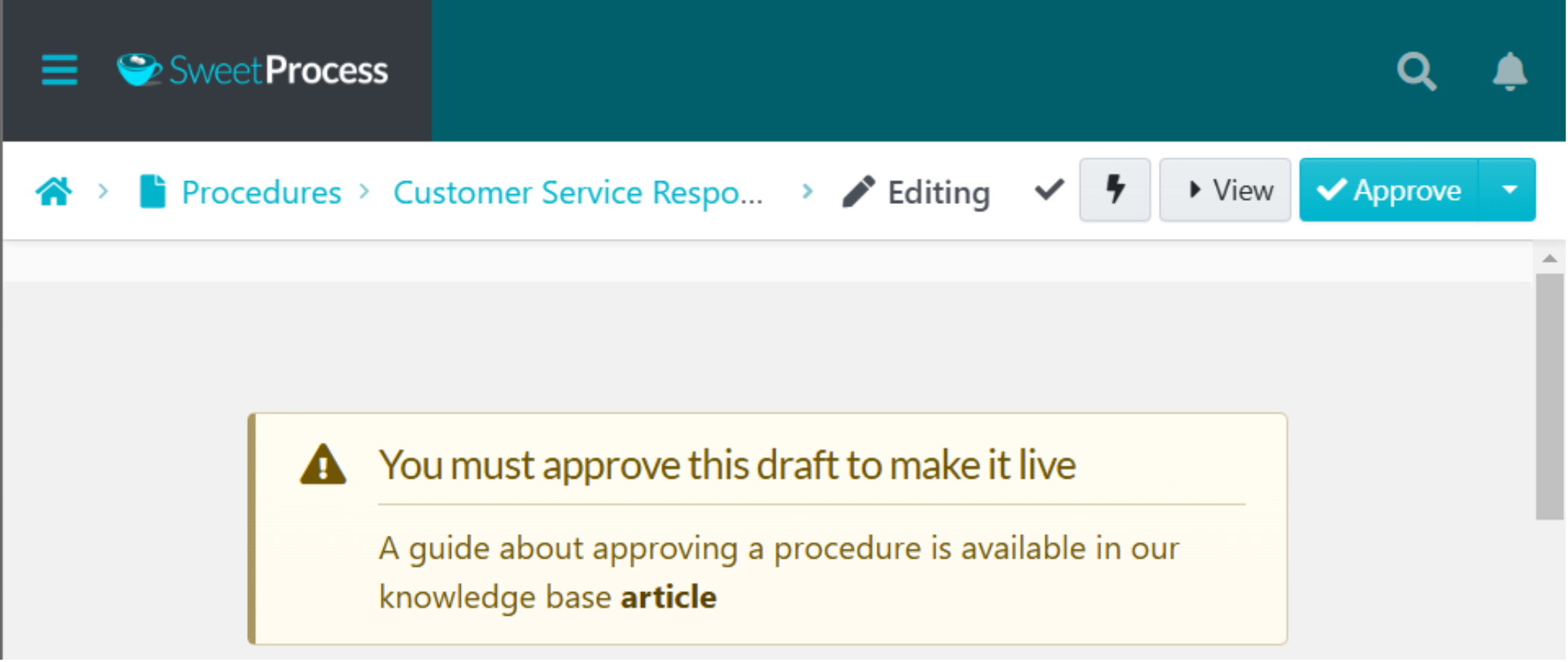
There you have it: documented steps to manage customer inquiries that automate the process for your customer service team using SweetProcess.
Perry Beebe, managing director of All Residential Real Estate, improved his company’s efficiency by transitioning from paper-based checklists to a cloud-based system using SweetProcess.
Previously, the company struggled with outdated documentation, inconsistent task execution, and reliance on experts for guidance. SweetProcess helped by providing clear, standardized procedures, enabling employees to work independently without needing expert supervision.
“The biggest thing was that we no longer need subject matter experts. Previously, there would be a person who was an expert and would answer everybody’s questions. But that person may not be in the office then.”
— Perry Beebe, Managing Director of All Residential Real Estate
Turn Procedures and Processes Into Actionable Tasks Using SweetProcess
Turning your procedures and processes into actionable tasks is the key to operational efficiency. Here’s how to turn your procedures into actionable tasks:
To assign a procedure or process, navigate to the “Procedures” or “Processes” tab in your SweetProcess dashboard and locate the specific procedure or process you want to assign.

Click on the three-dot menu (⋮) next to the procedure or process. Select “Assign as Task” from the drop-down options.

Configure the task details by deciding whether to assign a single task for multiple employees to work collaboratively or to assign individual tasks to each employee.
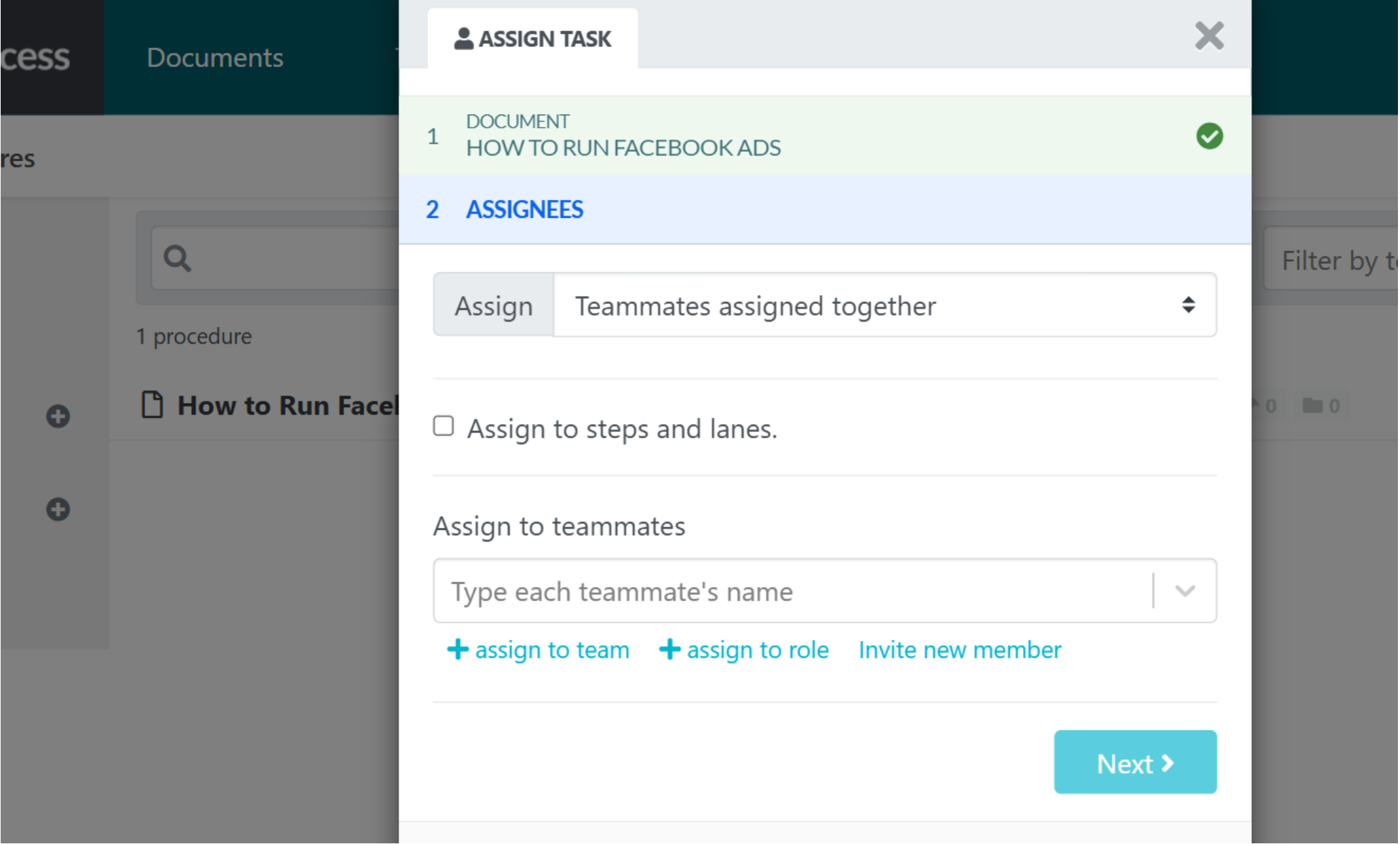
Select the assignees by choosing the employees or teams responsible for the task, including specific individuals, entire teams, or roles.

Set the due date and, if needed, the start time for the task, and determine whether assignees can begin the task before the specified start time.
If the task is recurring, define its repetition frequency, such as daily, weekly, or monthly, using SweetProcess’s flexible scheduling options.
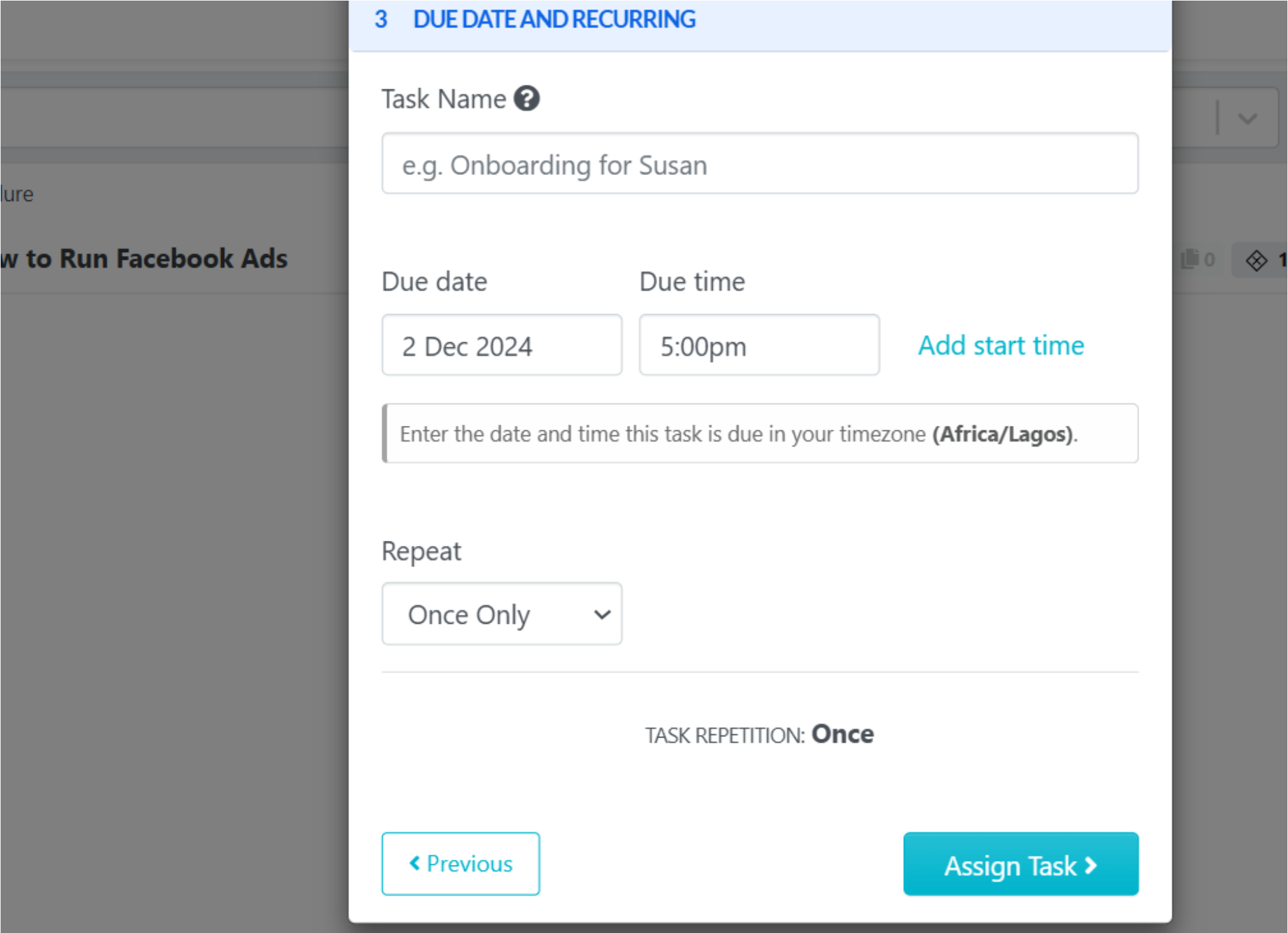
Finalize and Assign the Task
Check that all task details are correct, then click “Assign Task” to send it to your team. Employees will get notifications and reminders as the due date nears, and managers will be updated on overdue or completed tasks.
Following these steps, you can seamlessly convert your documented procedures and processes into actionable tasks within SweetProcess, promoting accountability and adherence to your organization’s standards.
Turn Existing Procedures and Policies Into a Beautiful Knowledge Base Using SweetProcess
Turning your existing procedures and policies into a well-organized knowledge base helps centralize critical information for easy access by your team. SweetProcess makes it easy to convert your documentation into a visually appealing, searchable resource that your employees can quickly reference. Here’s how to do it step by step:
Log in to SweetProcess and go to “Knowledge Bases,” located under the “More” section of the dashboard.

Click on “Create Knowledge Base,” then give it a name. For this example, we used “Facebook Campaign.”

You’ll be taken to a page where you can customize the layout and settings, including choosing whether the knowledge base will be internal for employees or external for customers.
You can customize who has access to the information and adjust the knowledge base to fit your brand using the “Control Access” menu.

After setting up the configurations, scroll to the bottom of the page to create different categories for help sections for your team.

Creating a category for documentation:

Click “Add new Article.” Select from the drop-down menu. Your existing procedures will appear as the displayed options.


There you have it: turning your existing procedures into a knowledge base your team can refer to when stuck.
Benchmark Wealth Management, a financial advising firm, struggled with inconsistent processes due to a lack of standardized documentation. It battled inefficiencies and confusion, particularly during employee onboarding and daily operations.
After discovering SweetProcess, the team streamlined its operations by creating clear, up-to-date, and actionable process documentation.
This eliminated outdated materials and reduced dependency on leadership for task execution. Employees gained more independence, and the firm experienced improved efficiency.
“We were struggling with processes. We did some searching on our own and stumbled on SweetProcess. It was a great stumble for us, and we really fell into it.”
—Sarah Beach, Branch Operations Manager at Benchmark Wealth Management
Manage Procedures, Processes, and Policies Using SweetProcess
Managing your company’s procedures, processes, and policies in one central location can significantly improve efficiency and reduce errors. SweetProcess makes managing and tracking these critical documents easy, ensuring everyone in your organization can access the most up-to-date information. Here’s how to attain business process management step by step using SweetProcess:
Sign up for a free trial here. Once logged in, go to the “More” section on the home page. Then click on “Procedures,” and you will find the “Create Procedure” button at the top-right corner, as explained earlier.
Create Processes From Existing Procedures
SweetProcess allows you to merge different procedures into one unified process that outlines how to perform specific tasks in your business.
For example, you could have separate procedures for order fulfillment, inventory management, and customer returns in an online store. Once these procedures are ready, creating a process from them is straightforward.
From the home page, click the “More” button. Under the “Procedures” section, click the “Processes” link. This will open a new page with the “Create Process” button at the top right corner.

Provide a title for your process on the next page, like “Online Shopping.” After that, click the “Continue” button to move forward.


In the “Steps List” section, click the “ADD STEP” button to include the procedures you’ve created for the current process, as shown in the image below.


As illustrated above, processes are groups of procedures collaborating to accomplish a particular task.
Managing Procedures and Processes
Managing your procedures and processes with SweetProcess is simple. Click the edit button at the top-right corner to edit a process.
Next to it is the “Actions” button, which opens a menu with options like duplicating the process, assigning it as a task to a team member, or exporting it to another format for easy sharing or printing. These features make it easy to keep your processes organized and adaptable.

How to Create a Policy in SweetProcess
Access the “Policies” button on the home page. Click “Create Policy” in the top-right corner.

Enter a relevant title for your policy and click “Continue.” You can also ask SweetAI to write it for you.

In the next step, you get a page to fill out the details of your policies. After completing it, click “Save” to store it. When ready to make the policy available to your team, click “Approve” to publish it.
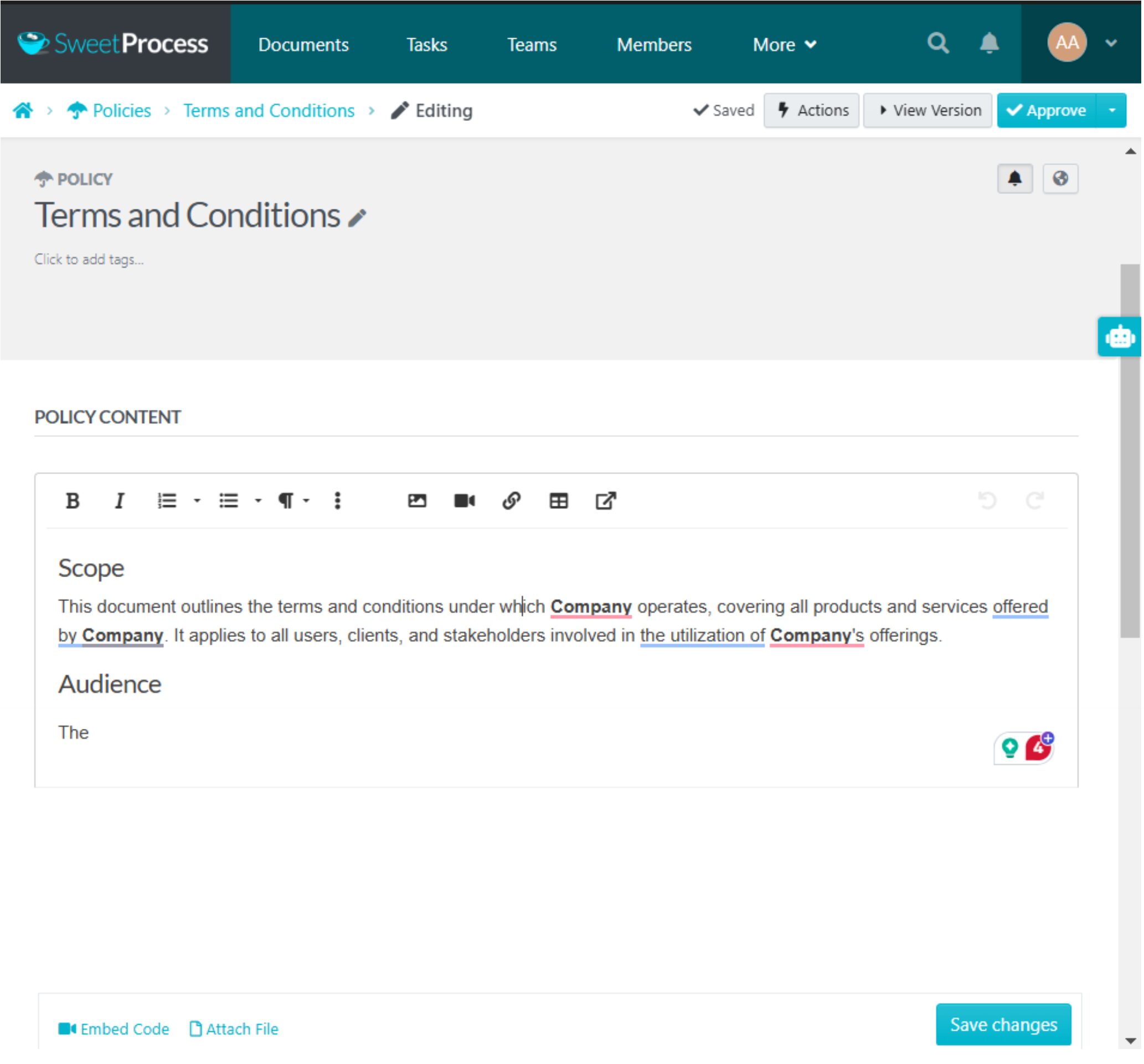
Ease Policy Management With SweetProcess
Once you create your policy, make it accessible and update it regularly or as needed. SweetProcess makes reviewing and updating your policies easy. You can also set reminders to ensure you don’t forget. To set a reminder, just go to the policy and click the “Review” icon.
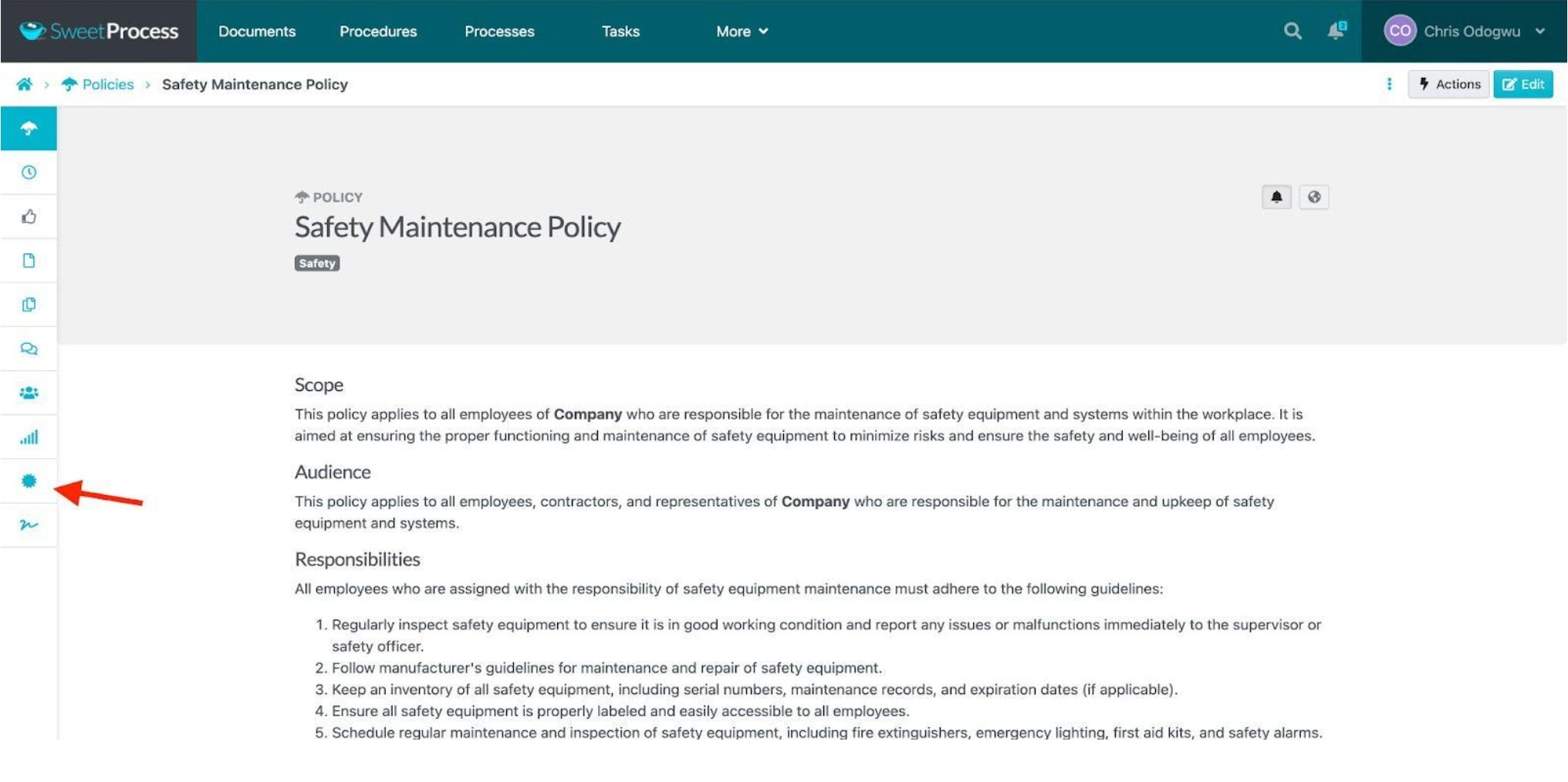
The review feature is disabled by default. Click on “Enable” to activate it.
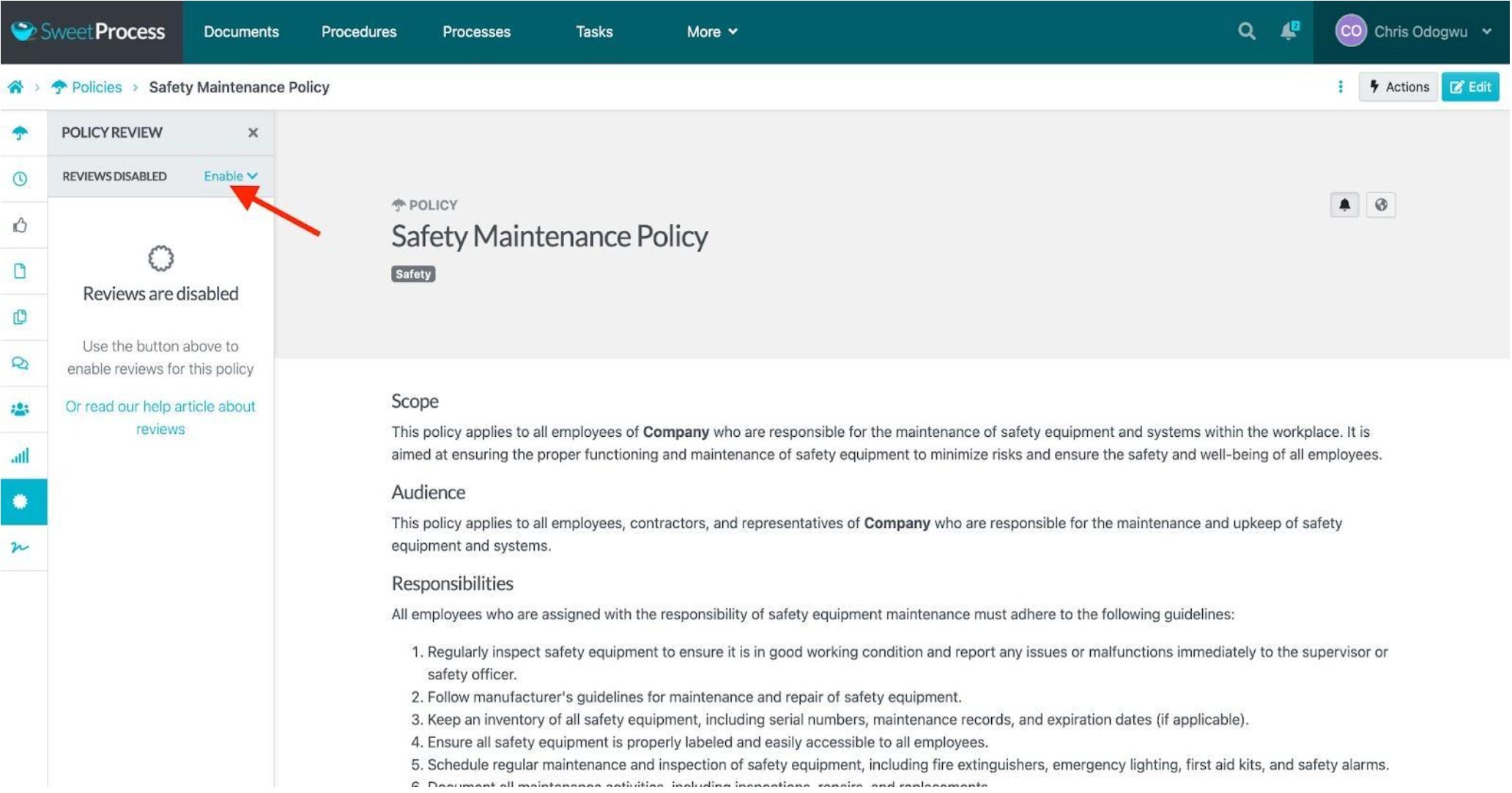
The default date is one year from when you enable it, but you can choose a preferred date.

All team members assigned to the policy will be notified about the upcoming review. A week before the review, SweetProcess will show a “Needs Review” label next to the policy title, and you will get a reminder notification.
Assign Tasks and Collaborate With Team Members Using SweetProcess
SweetProcess makes it easy to assign tasks, track progress, and work with your team. Here’s how to delegate tasks and collaborate using SweetProcess:
Navigate to your dashboard’s “Task” tab and click the “Assign Task” button on the right.

The next page after this will prompt you to select the specific task you want to assign. This could be from your existing processes or procedures. After selecting the appropriate task, the next step concerns the specifics of the assignment and the team to handle it.
Say the task is about onboarding new employees. You can assign each step of the onboarding process to various members or one person.
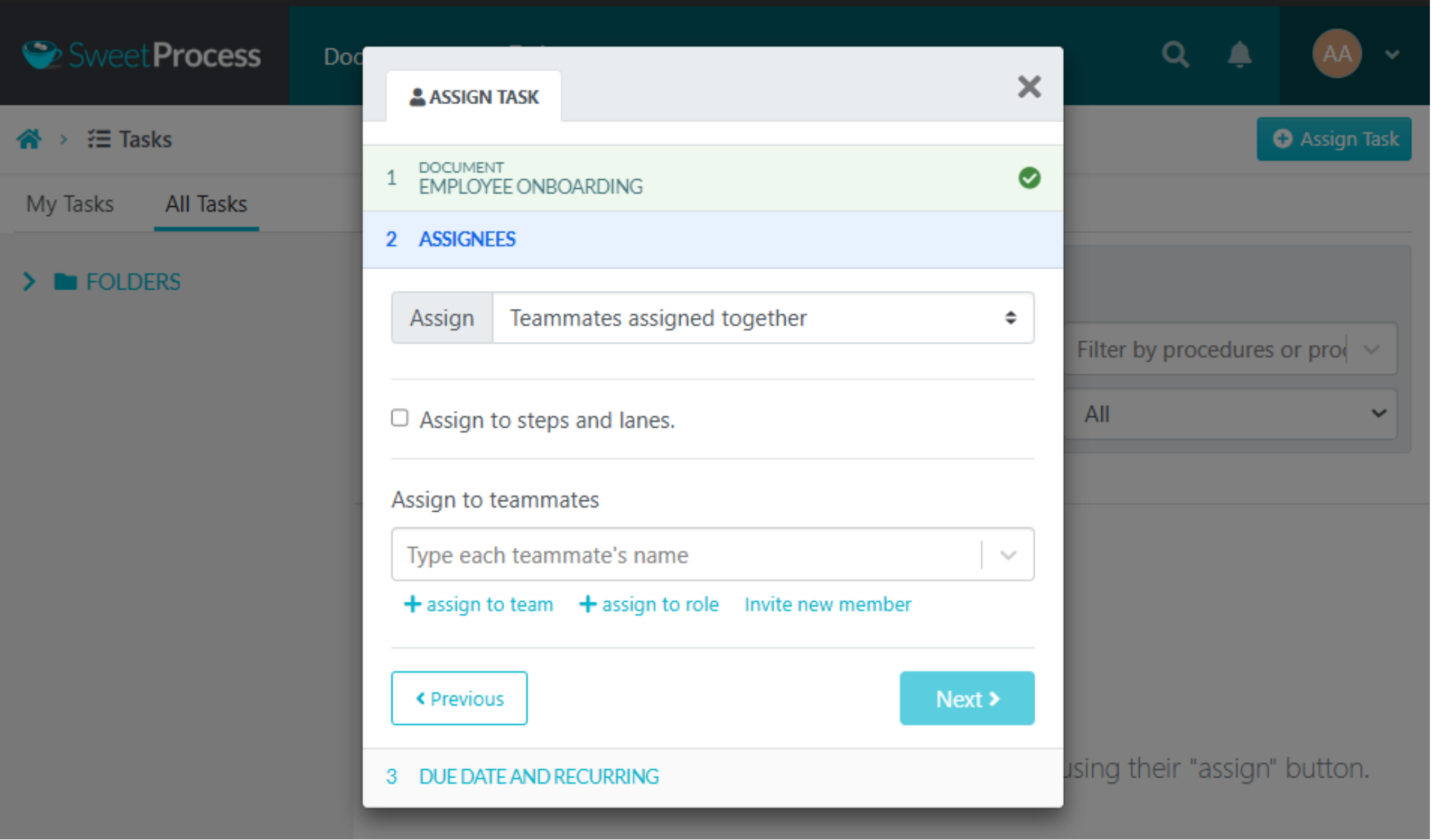
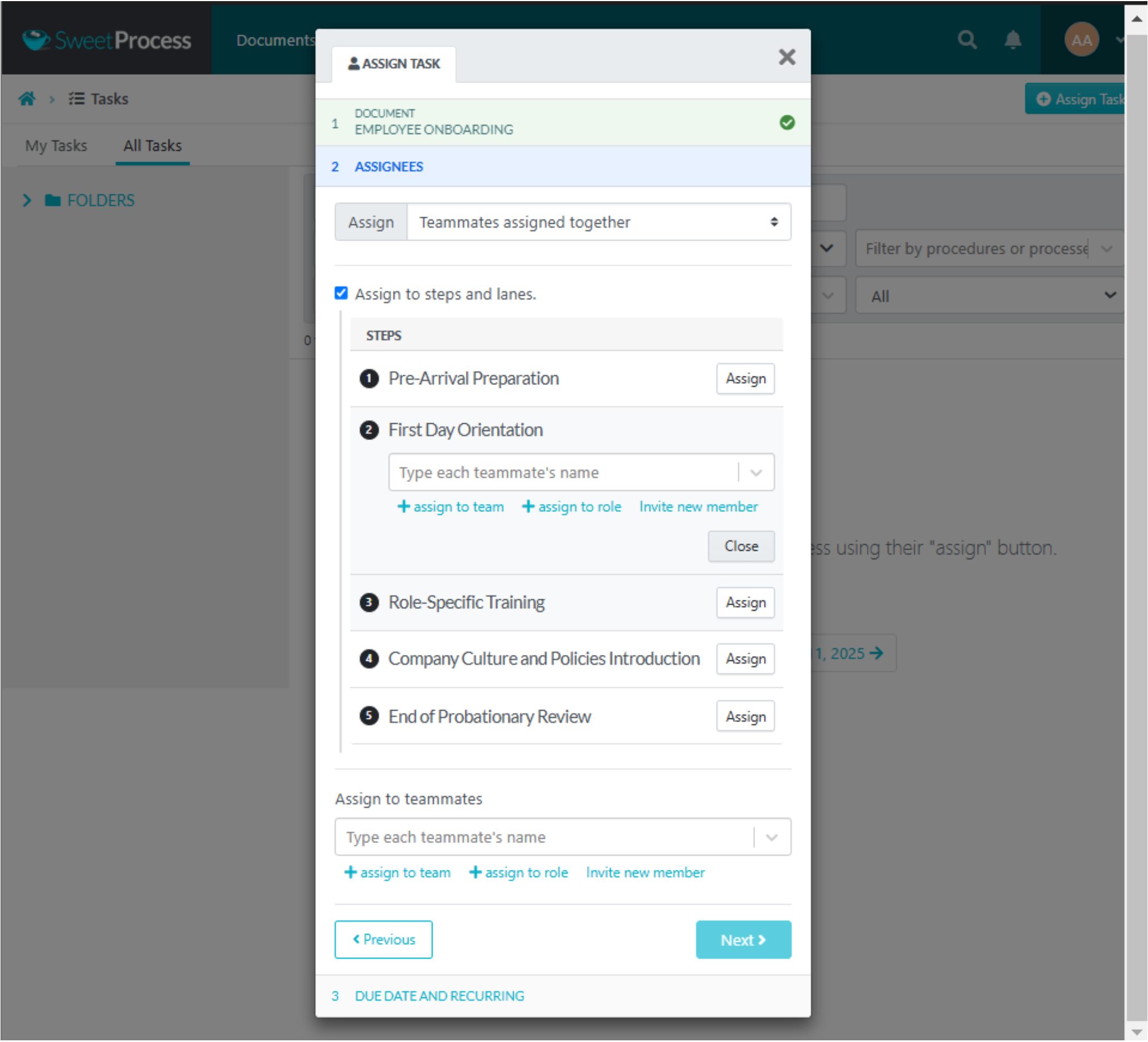
Next, you specify the start and due date for the assignment. For recurring tasks, you can set the frequency as best suited.

Once the details are in place, click “Assign Task” at the bottom.
Operoo, an Australian company that helps businesses, especially schools, go paperless by automating paperwork, faced challenges with inconsistent manual processes as it grew. CEO Troy Westley struggled with onboarding and training employees, frequently needing to explain procedures. This inefficiency slowed down operations and led to mistakes.
Frustrated by the time and cost spent correcting errors and micromanaging employees, the company turned to SweetProcess after evaluating other options.
SweetProcess helped Operoo streamline its workflow, making process documentation easier and enabling efficient training for in-house and remote staff. It improved processes across sales, marketing, HR, and customer support.
“We’ve got employees in four different countries. Everybody knows what they are supposed to do and how to do it. I don’t have to worry that things aren’t being done right because it’s clear. There’s consistency throughout the organization.”
—Troy Westley, CEO of Operoo
5 Process Automation Examples to Implement in Your Business

Process automation helps you concentrate on what’s important while minimizing errors and inefficiencies. It’s an essential tool for growing a business efficiently. Here are five areas where automation can have a significant impact.
Recruitment
Managing the recruitment process manually can be overwhelming. Sorting through numerous resumes, scheduling interviews, and sending follow-up emails can consume much time.
However, automating job listings, candidate screening, and interview scheduling makes the process faster and more organized. It also allows the HR team to focus more on evaluating candidates than handling repetitive tasks.
Employee Onboarding and Training
Onboarding and training new employees can be challenging due to the numerous paperwork requirements and coordination between different teams. However, implementing an automated onboarding system streamlines these processes.
The distribution of training materials and tracking employee progress are tasks that can be fully automated, saving time and reducing administrative workload.
Payment and Payroll Processes
Managing payroll manually is risky and time-consuming, but automating it makes the process effortless and reduces the risk of errors or legal issues. Payroll software also ensures compliance with tax regulations and saves the finance team significant time each month.
Workforce Scheduling
Automating workforce scheduling with just a few clicks simplifies the process, making assigning shifts based on employee preferences and availability easy. Additionally, the system allows employees to request time off or swap shifts easily, saving time and boosting employee satisfaction.
Compliance and Regulatory Tasks
Regulatory compliance can be one of the most challenging aspects of business, especially with changing regulations and shifting deadlines. Automating compliance processes helps organizations track regulatory deadlines, maintain proper documentation, and quickly generate reports.
For example, SweetProcess sends reminders and alerts when tasks are due.
Best Practices for Process Automation Success
It’s easy to get lost in the excitement or struggle to figure out how things work when automating a business process. To ensure success with process automation, your approach should be strategic. Here are some best practices that will set you up for long-term success:
Identify and Prioritize Processes

You don’t need to automate every aspect of your business all at once. The key is to identify the processes with the most significant impact when fully automated. Start by identifying repetitive tasks or processes that are time-consuming or lead to frustrating customer experiences. Then, choose the process that will most positively affect productivity and business goals.
Build the Business Case
Before business automation, first build a solid business case. Demonstrate how automation will add value, which may be through saving time, cost, or improving productivity. Also, ensure you gather enough data to show improvements and let the automation strategy align with your overall business process goals.
Design Flawless Automation
Once you’ve built the business case, it’s time to design flawless automation that’s smooth and efficient. The best automation tool integrates naturally with existing workflows.
Automate processes in a way that minimizes complexity and enhances the end-user experience. Focus on intuitive automation that solves problems without creating new ones.
Start Small, Demonstrate Value
You don’t need to automate everything at once. Start by automating a single process and observing the value it delivers.
Once you’ve perfected that, move on to the next process. Demonstrating value early helps build momentum and sets the pace for subsequent automation.
Choose the Right Technology
Your success may depend on the technology you choose for your process automation. As such, select a tool that integrates with your existing systems. Also, the most expensive tool does not necessarily translate to the best solution. Hence, choose a scalable and user-friendly business process automation software.
As such, SweetProcess is an excellent choice for process automation because it allows you to document and automate tasks easily while offering integrations with other tools you might already be using.
Develop Governance
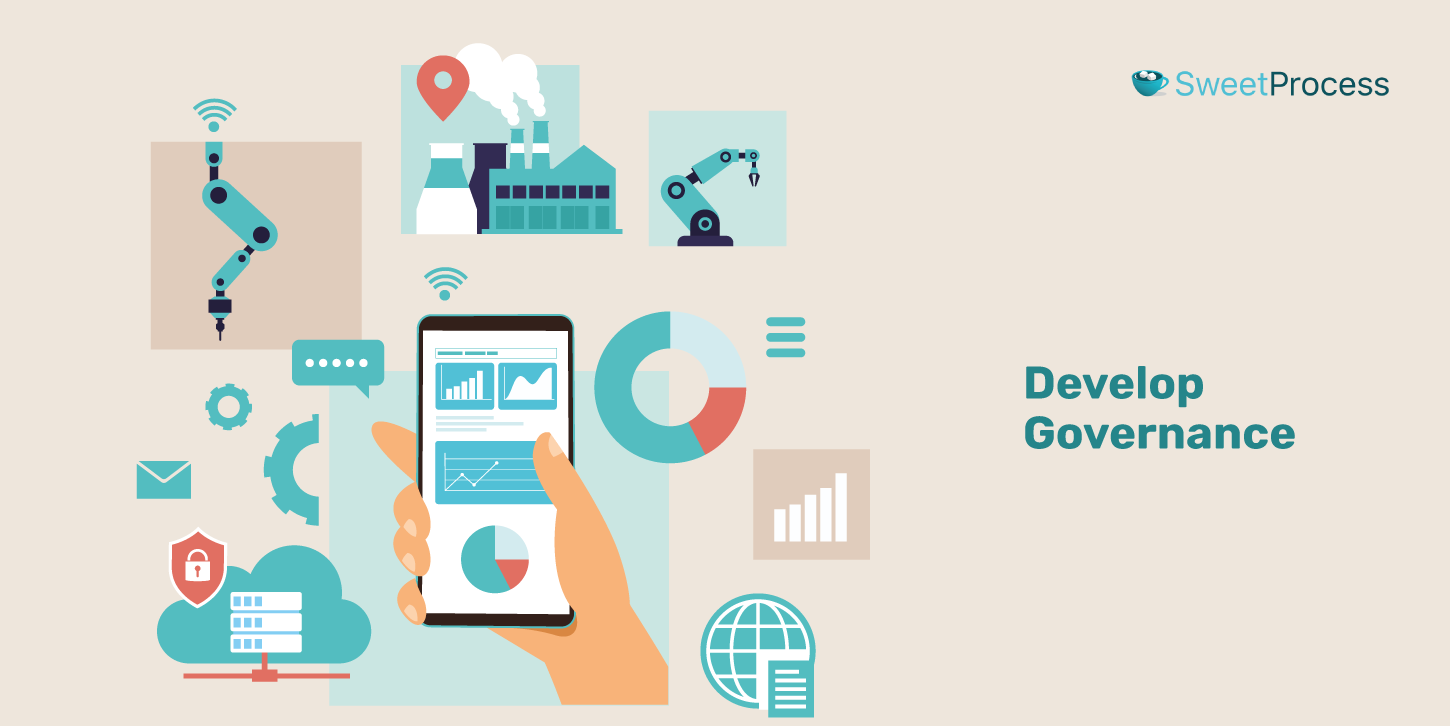
For your automation to be effective, it is essential to develop strong governance—set clear goals and create roles and responsibilities for automation management. This also includes establishing guidelines for automation monitoring and updating and a process for addressing issues that arise.
Monitor Closely
Once process automation is deployed, performance monitoring starts. You should check how the system is performing against the result you have targeted. Monitor metrics such as time saved, cost saved, and error reduced, among others.
Additionally, listen to your team’s and customers’ feedback to see how automation affects their experiences. With continuous monitoring, you can spot bottlenecks and finetune where necessary.
Manage Organizational Change
Process automation will lead to a cultural shift in your organization, especially if you have spent years handling things manually. As such, you should help your employees see the benefits of automation and how it makes their jobs seamless, not replace them.
Therefore, you provide adequate training, address concerns, and create an enabling environment where they feel empowered to adopt new technology. When changes are properly managed, your automation will succeed.
Some Techniques and Terms Used in Process Automation
When you’re new to process automation, it’s easy to get overwhelmed by the terms and techniques involved. Here are some key terms and techniques to familiarize yourself with:
Hyperautomation

Hyperautomation goes beyond automating isolated tasks. It involves automating many processes using various tools, such as robotic process automation (RPA), artificial intelligence (AI), machine learning (ML), and more. It’s about automating the entire workflow to improve efficiency across the organization.
Intelligent Process Automation (IPA)
Intelligent process automation (IPA) combines traditional tools like RPA with AI and machine learning. IPA makes repetitive tasks smarter and faster by allowing systems to execute commands, learn, adapt, and make data-based decisions. This is particularly useful for customer service queries or managing complex business decisions in real time.
Low-Code/No-Code Automation
Low-code and no-code platforms are ideal for business process automation without the need for developers. These platforms allow you to create automated workflows without coding experience—simply by dragging and dropping pre-built templates. This democratizes automation, allowing non-technical staff to implement automation and freeing up IT teams for more critical tasks.
Big Data
Big data refers to large volumes of information from various sources like customer interactions, sales transactions, and IoT devices. In process automation, big data helps optimize operations by analyzing vast datasets to predict trends, improving decision-making, and streamlining business processes.
Artificial Intelligence (AI)

AI is the backbone of many automation systems, enabling machines to mimic human intelligence. In process automation, AI allows systems to respond to unforeseen situations and adapt to new tasks, making automation more flexible and intelligent.
Natural Language Processing (NLP)
NLP is a branch of AI focused on understanding and interpreting human language. In process automation, NLP is crucial for reading and understanding emails, processing customer feedback, or analyzing legal documents.
Automation tools with NLP capabilities can understand communication’s context, sentiment, and intent to provide appropriate responses, leading to more efficient customer service and other processes.
Machine Learning (ML)
Machine learning allows systems to improve over time by learning from data. In process automation, ML analyzes data to predict future behavior and optimize processes. ML makes automation predictive and dynamic, improving customer experiences by anticipating needs.
Intelligent ERP Systems
Intelligent ERP (enterprise resource planning) systems integrate core business functions like finance, HR, and supply chain management. With AI and ML, these systems automate tasks and centralize data, improving inventory management, financial reporting, and demand forecasting processes.
Meanwhile, getting to know these terms is not enough. If you want to witness how these technologies can transform your business process through automation, sign up for a free trial of SweetProcess.
Challenges of Process Automation
Despite automation being a game changer for businesses, implementing it efficiently and effectively comes with some challenges. Here are some common challenges you may encounter when automating your processes.
Difficult to Scale
Scaling automation is not always easy. For instance, initial systems may lack the flexibility to adapt as your business grows, creating bottlenecks and inefficiencies.
As such, what starts as a solution can quickly become a limitation without proper planning. Additionally, employee resistance to adoption and a lack of strategic direction from management are other challenges to scaling automation.
Errors in Implementation
Poorly designed workflows, inadequate employee training, and issues breaking down process steps often lead to errors during automation implementation. These errors can waste time and resources and quickly disrupt operations if not addressed.
To avoid these issues, consider using automation software, such as SweetProcess, to help break down processes into manageable steps.
Attempting to Implement Everything at Once
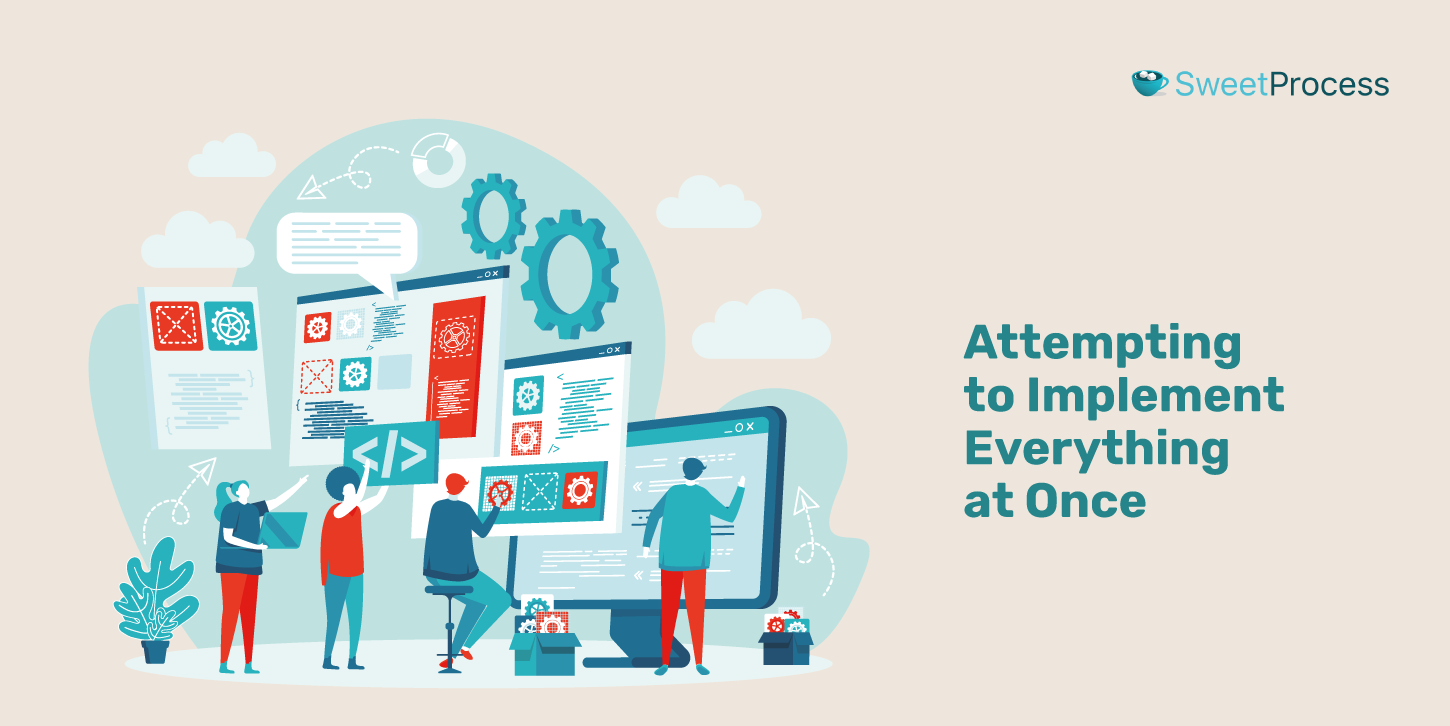
While your business can greatly benefit from process automation, it’s crucial not to see it as a catch-all solution. Trying to automate everything at once can lead to frustration and confusion. A more strategic, step-by-step approach allows your teams to focus, learn, and improve as they continue their automation journey.
No Goal Management
Attempting automation without clear objectives is like setting out on a journey without a map. It’s essential to define measurable goals to give your efforts purpose, align them with your processes, and establish benchmarks for success.
Once goals are set, monitoring workflows and ensuring continued progress is equally important. Ongoing management and evaluation of the system are necessary for sustained success.
These challenges may seem daunting, but they are entirely avoidable. With SweetProcess, you can easily document, streamline, and automate your workflows.
Process Automation vs. Robotic Process Automation

Two key terms often arise when discussing process automation: process automation (PA) and Robotic Process Automation (RPA). While they may seem similar at first glance, they refer to different concepts that can influence how automation is implemented within an organization.
The primary difference between the two lies in the scope and complexity of their approaches to automation. Process automation (PA) is an umbrella term for automating complex business processes. This encompasses tasks, workflows, data management, and decision-making. PA also integrates various tools and technologies, such as AI, machine learning, and others, to automate end-to-end processes.
On the other hand, robotic process automation (RPA) is a subset of process automation that focuses specifically on automating routine and repetitive tasks traditionally performed by humans. These tasks are typically rule-based and involve structured data, such as data entry, transaction processing, or responding to simple queries.
Here’s a side-by-side comparison to better highlight the key differences:
| Aspect | Process Automation | Robotic Process Automation (RPA) |
| Scope | Covers entire workflows, including decision-making and integrations. | Focuses on automating repetitive tasks using robots or bots. |
| Complexity | Can handle complex workflows involving both structured and unstructured data. | Primarily designed for simple, rule-based tasks. |
| Technology Used | Uses AI, machine learning, analytics, and cloud computing to automate processes. | Primarily uses pre-configured scripts or bots to mimic human actions. |
| Flexibility | High flexibility in terms of adapting to different processes and business functions. | Limited flexibility, best suited for well-defined, repetitive tasks. |
| Decision-Making | Can incorporate decision-making based on data and logic. | Limited decision-making ability; executes predefined actions. |
| Implementation | Requires more effort to integrate and configure various systems and technologies. | Quick to implement, especially for isolated tasks or processes. |
Which One Should You Choose?
For businesses involved in a high volume of repetitive, rule-based tasks that don’t require decision-making, RPA suits you because it is quick, cost-effective, and easy to implement.
Conversely, process automation is the better option to automate entire processes, including complex workflows, data analytics, and decision-making. SweetProcess has the tools you need to do most of the automation. Sign up for a free trial.
Enhance Your Company’s Process Automation Using SweetProcess
Process automation goes beyond improving efficiency; it reduces human error and drives growth. Automating repetitive tasks and streamlining decision-making can free up more time to focus on high-value work.
The best part? Implementing process automation doesn’t have to be complex or costly. SweetProcess offers an intuitive, user-friendly platform that easily documents, manages, and automates your business processes.
If you are ready to take your business to the next level, sign up for a free trial of SweetProcess today.
